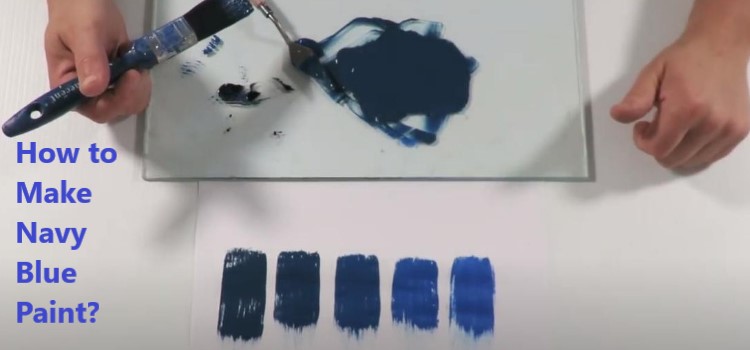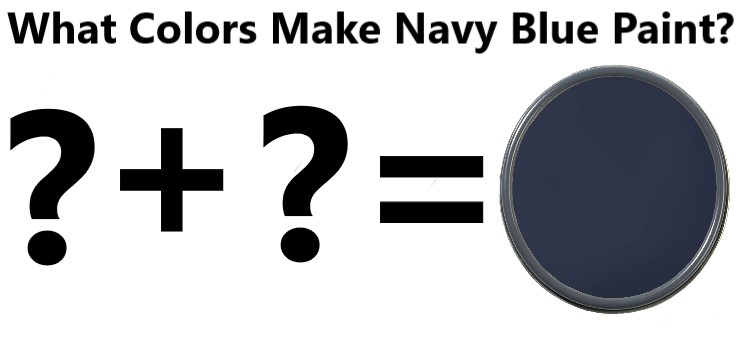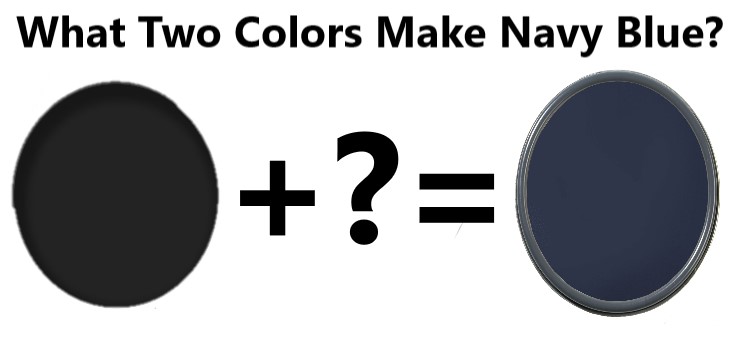Navy blue, a decent color that many people are obsessed with! From living rooms to exteriors, navy blue goes with everything. This magical color has something special in it. Depending on the different hues of darkness, it softens rooms and brings coolness to the eyes.

If you are planning for navy blue walls, this article is just the thing you are looking for. This tiny guide has it all from choosing the required colors to making the perfect shade of navy blue paint. So, grab your paint rollers and paintbrushes to find out how to make navy blue paint?
Contents

If you are making a ‘scientific color experiment’ without having the basics of color theory, you might never get to say ‘Eureka’ loudly! So, before we dive into the nitty-gritty of how to construct navy blue shade or what mysterious colors make navy blue, let’s take a brief look at the basics of color theory.
Color Theory
The color theory is simple and we are making it fit in an M&M chocolate bowl so that you can grasp a handful of info in no time.
According to the boring ‘wise owl’ term, color theory is a set of rules and regulations used by designers to communicate with a user to show them the appealingness of colors in a visual interface.
But in simple words, the color theory works with different types of colors around us and shows how they mix, contrast, or match with each other. And basically, the colors we see around us are divided into three groups: primary, secondary, and tertiary colors.
Primary Colors (Ps):
Primary colors are the roots of all colors. All the colors we see around us somehow originate from them. There are three primary colors: red, blue, and yellow.
Secondary Colors (S’):
Secondary colors are the mixtures of two of the three primary colors. Like primary colors, the number of secondary colors is also three: green, orange, and purple.
Tertiary Colors (Ts):
Tertiary colors are produced when a primary color is mixed with a secondary color. There are six tertiary colors; blue-violet, blue-green, yellow-orange, red-violet, red-orange, and green-yellow.
Okay, now you have the basics of color theory. It’s time to find out the answer to what colors make navy blue?
Navy blue is neither a primary nor a secondary color. So, you need to blend your own colors to achieve a rich navy blue hue.
You can make navy blue tint using different combinations of two of these three colors: pure blue, black, or orange.
Read Next: How to make teal paint at home
As mentioned earlier, a combination of pure blue and black, or pure blue and orange makes navy blue. So, if you want to go with the first combination, mix pure blue shade with black and you will get a rich navy blue hue. This combination is the easiest way of making a navy blue shade.

On the other hand, if you take the second combination, this will work pretty well as well. But while using orange, you can’t take the same amount of it as the blue shade. If you use the same amount of blue and orange you will end up getting somewhat close to a version of a tertiary color, brown. So, you have to use blue more than orange to give it a darker look and eventually a navy blue shade.
But isn’t it weird that at first, it was brown and now it’s navy blue? A question may pop into mind, ‘how and why does it happen’? Let’s find out why orange works for navy blue.
When you are starting an experiment on making new colors, a color wheel appears to be very useful to figure out which shades can be blended together and which shades cannot be. But before you start blending, you need to have the basics of the color wheel. So, what actually is a color wheel?
Well, a color wheel is or color circle is a circle that contains different colors hues around it and shows the relations between them. A color wheel contains primary, secondary, and tertiary colors in a specific order.
Okay, getting back to the topic, in the color wheel there is a term called complementary colors, which refers to colors that sit opposite to one another in the color wheel. If a small amount of one complementary color is mixed with the other color, it creates a darker hue of the paint that has the larger amount. For instance, red and green are complementary colors so, if you were to take a small amount of red and mix it with bright green, it will give you a darker hue of green.
Now, in the case of our pure blue and orange, they are complementary colors too. So, if you make a combination of these two colors you will get a navy blue tint. Also, we are making navy blue, so, we need to take the portion of pure blue in a larger amount compared to orange.
Read Next: Step by step metallic paint making guide
Okay, now you have the knowledge of color theory and colors that make navy blue. It’s time to get practical, make some navy blue paints, and shout ‘Eureka’ loudly! So, first, let’s take a look at the ingredients for making navy blue paint.
- Pure blue paint
- Black or orange paint
- A disposable bowl
- Paintbrush or roller
- Stir stick
- A plastic drop cloth
- Sample navy blue paint chip
We have all the stuff we need. Now, it’s time to check the key steps to make a perfect navy blue hue.
Step Number 1:
Cover the floors and furniture with a drop cloth to protect them from getting unwanted paint stains.
Step Number 2:
When it comes to blending and making a new color, measuring the paints properly is very important. In our case, if you are using black with blue, take a very small amount of black depending on the blue hue. But if you take two paints of pure hues like blue and orange, you have to take 1 part of the orange and 3 parts of blue to achieve a navy blue hue.
Step Number 3:
Pour some of the pure blue paint into a bowl, approximately as much as required for your project.
Step Number 4:
Now, add a few amounts of black or orange paint depending on the amount of blue you took. Use the same type of paints for mixing. It’s not necessary to match the brands, but you must match the basic type of paints. For instance, you have to use alkyd blue with alkyd black or watercolor blue with watercolor black.
Step Number 5:
Add a few more amounts of orange or black if you think the mixture seems a little lighter than you expected. On the contrary, if you find out that the mixture looks a bit darker you can use a few amounts of the pure blue and stir it again to get your desired hue.
Step Number 6:
Now, test the blended paint on white paper. You may try light and bold strokes with your paintbrush and compare them with a sample navy blue paint chip. If it matches your desired navy blue hue, you can blend more of it in larger scales to meet your project requirements. But if it still doesn’t match, repeat step 5 until you achieve your desired hue.
Finally, after achieving your desired navy blue hue, you may use an airtight container for storing the paint mixture for further use.
Read Next: How to make gold color paint
Final Words
From decorating walls to choosing the colors for repainting corporate office rooms, navy blue is an ideal choice for all. It gives a royal touch to modern interiors and exteriors. And to achieve the desired navy blue hue, choosing the proper amount of colors is the key.
Keeping this tiny guide in mind, you can easily achieve the perfect navy blue hue, just like you were expecting. So, start experimenting with colors and paintbrushes, make your desired navy blue hue, and shout ‘Eureka’ loudly. But, don’t be like Archimedes, don’t forget to wear pants before running through the neighborhood shouting ‘Eureka’!
